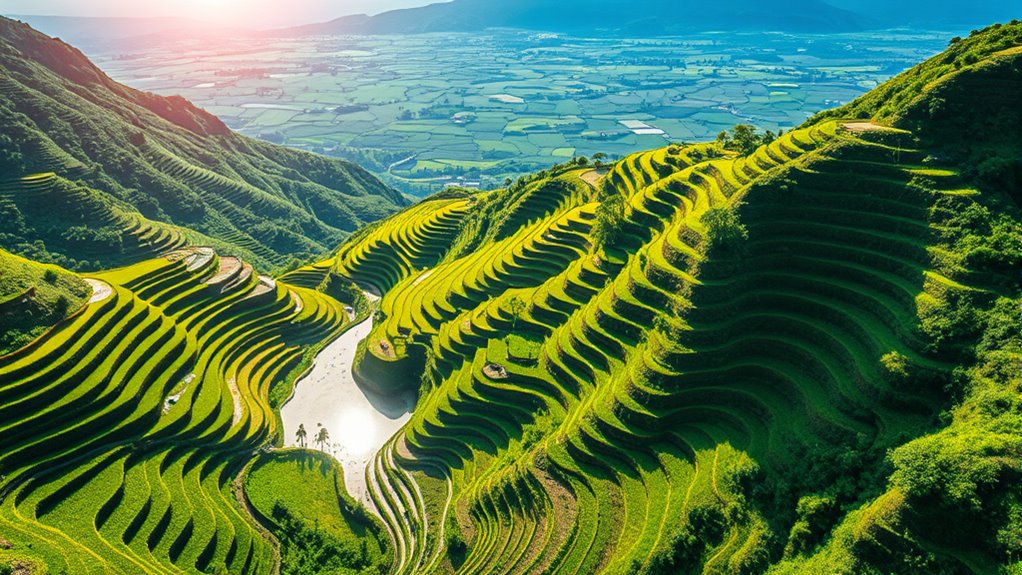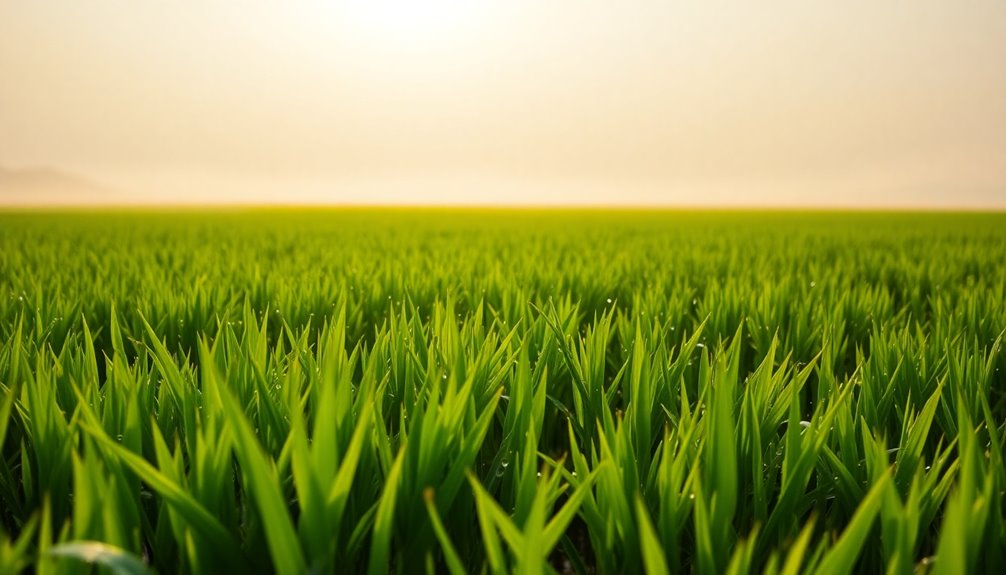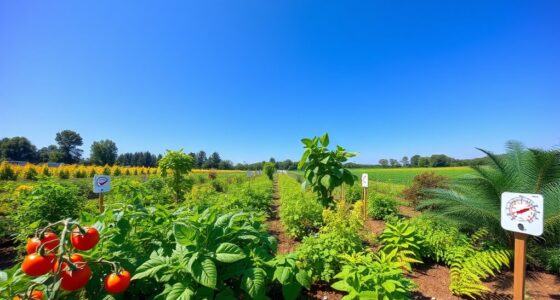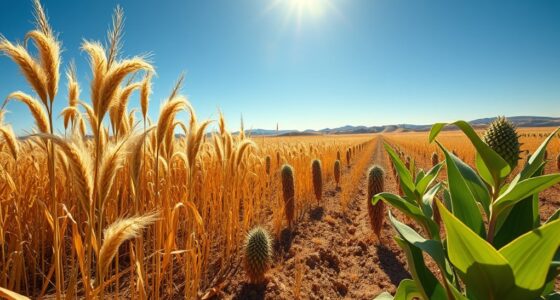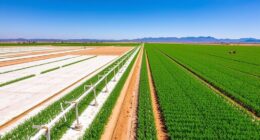Terrace farming is an essential agricultural method that turns steep hillsides into flat, usable land for growing crops. It helps control water runoff and prevents soil erosion, making it vital for food security, especially in mountainous regions. This practice not only boosts crop yields but also promotes sustainable farming. By appreciating its global diversity and cultural significance, you can understand why terrace farming's value extends beyond crops. There's so much more to discover about its impact and techniques.
Key Takeaways
- Terrace farming transforms steep slopes into arable land, enabling crop cultivation in mountainous regions where traditional farming would be impossible.
- It prevents soil erosion and controls water runoff, promoting sustainable agricultural practices and environmental conservation.
- Historically significant, it has been used by ancient cultures, such as the Incas, to optimize food production in challenging terrains.
- Different techniques, like contour and bench terracing, enhance water management and soil retention, boosting crop yields and quality.
- Terrace farming fosters community development, preserves cultural heritage, and contributes to food security in various global regions.
Definition of Terrace Farming

Terrace farming is an innovative agricultural technique that transforms steep hillsides into flat surfaces for crop cultivation. By creating terraces, you control water runoff and prevent soil erosion, making it easier to grow crops in challenging terrains.
Terrace farming transforms steep hillsides into arable land, enhancing crop growth and preventing soil erosion.
These flat areas, resembling steps, provide arable land in mountainous regions. You'll find two main types of terracing: graded and level, each tailored to different landscapes.
This method is particularly popular in areas with steep slopes, such as Asia, the Mediterranean, and South America.
By utilizing terrace farming, you're not just increasing productivity; you're also promoting soil and water conservation, ensuring your crops thrive while protecting the environment.
It's an effective way to maximize agricultural potential on difficult land.
Historical Significance of Terrace Farming
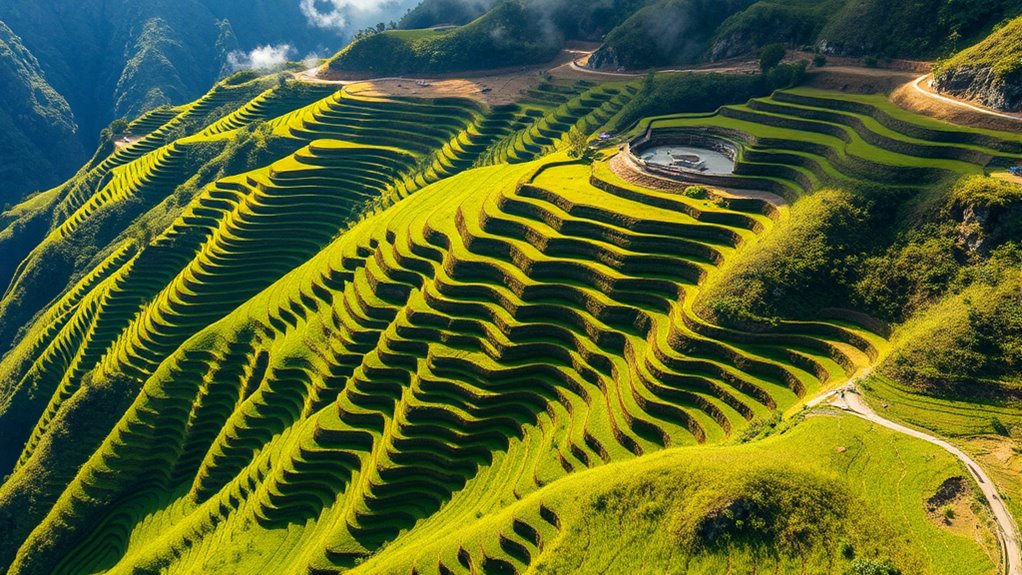
The historical significance of terrace farming reveals its profound impact on agriculture and culture across various civilizations.
You'll find that this method dates back thousands of years, with the Incas in South America showcasing advanced terracing systems to cultivate crops at high altitudes.
Asian cultures, particularly in rice-growing regions like Vietnam and Indonesia, also adopted terraces to optimize water usage and soil conservation.
As this technique spread globally, it adapted to diverse terrains, preserving cultural heritage and traditional practices.
By preventing soil erosion and increasing crop yields, terrace farming not only enhanced agricultural productivity but also contributed to food security.
This remarkable innovation continues to shape economies and lifestyles in many regions today.
Global Practices of Terrace Farming
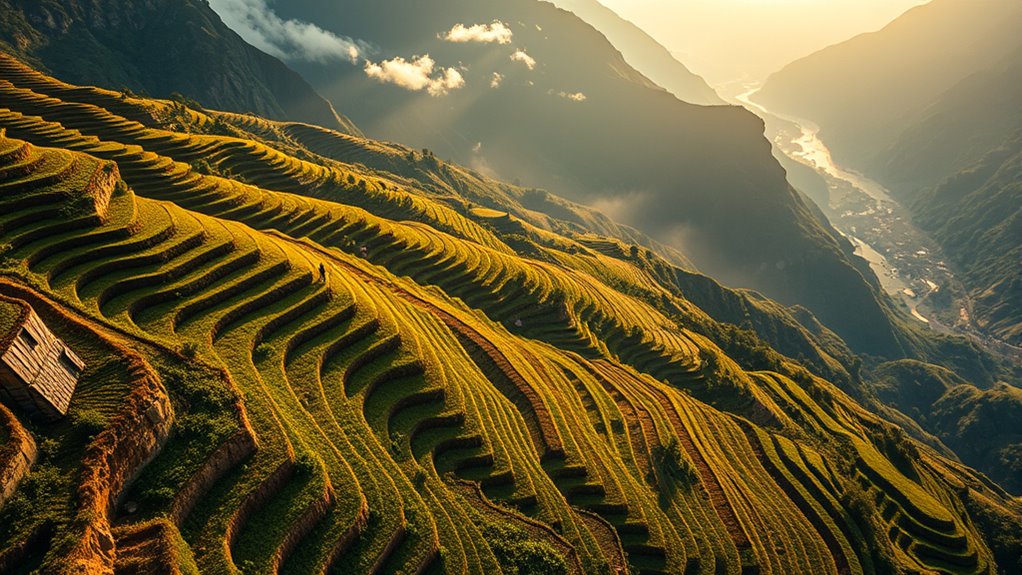
Across the globe, terrace farming plays a crucial role in adapting agriculture to diverse landscapes and climates.
In Asia, countries like Vietnam and Indonesia utilize terraces for rice and tea, while Africa's Andes region grows coffee and tea.
South America honors its Inca heritage by cultivating potatoes and maize on terraces.
Europe employs this method for vineyards and specialty crops, similar to North America, where it's used for efficient land management.
Beyond crop production, terrace farming offers environmental benefits, such as reducing soil erosion and conserving water.
It's a sustainable solution that boosts food security and creates jobs.
Types of Terrace Farming Techniques

When considering the various techniques of terrace farming, you'll find that each method is uniquely designed to address specific environmental challenges and crop needs.
Contour farming involves creating terraces along slope contours to prevent erosion and retain moisture. If you're dealing with steep slopes, bench terrace farming conserves water by trapping it for crops below.
Stepped terrace farming suits gentle slopes and helps retain moisture for crops like rice. For well-drained soil requirements, raised-bed terrace farming improves drainage.
Flat terraces are perfect for rice, allowing fields to be flooded. These techniques, along with essential features like retaining walls and drainage systems, combine to create a sustainable farming environment tailored to various landscapes and crop types.
Benefits of Terrace Farming for Agriculture
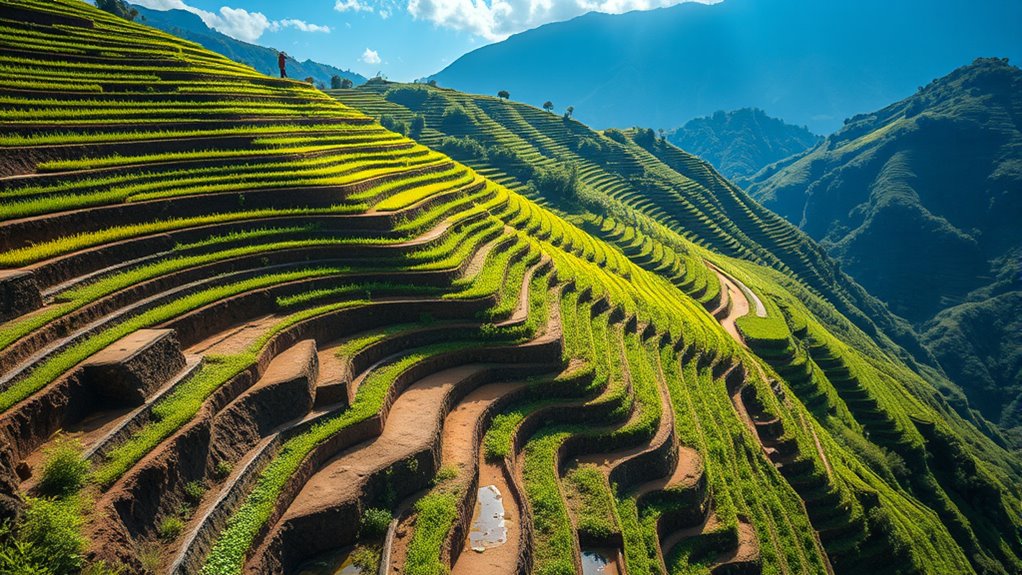
Terrace farming offers numerous benefits that can significantly enhance agricultural productivity. By providing stable, flat land for planting, you can increase crop yields and make better use of previously unusable areas.
The improved water management and soil retention lead to higher crop quality and support diverse cultivation of grains and vegetables. Economically, it reduces labor costs over time, boosts profitability through better yields, and promotes local employment.
You'll also find that it conserves soil and water, preventing erosion and minimizing the need for fertilizers. Ultimately, terrace farming not only secures consistent harvests in challenging terrains but also fosters community development and cultural heritage, making it a vital practice for sustainable agriculture.
Environmental Impact of Terrace Farming
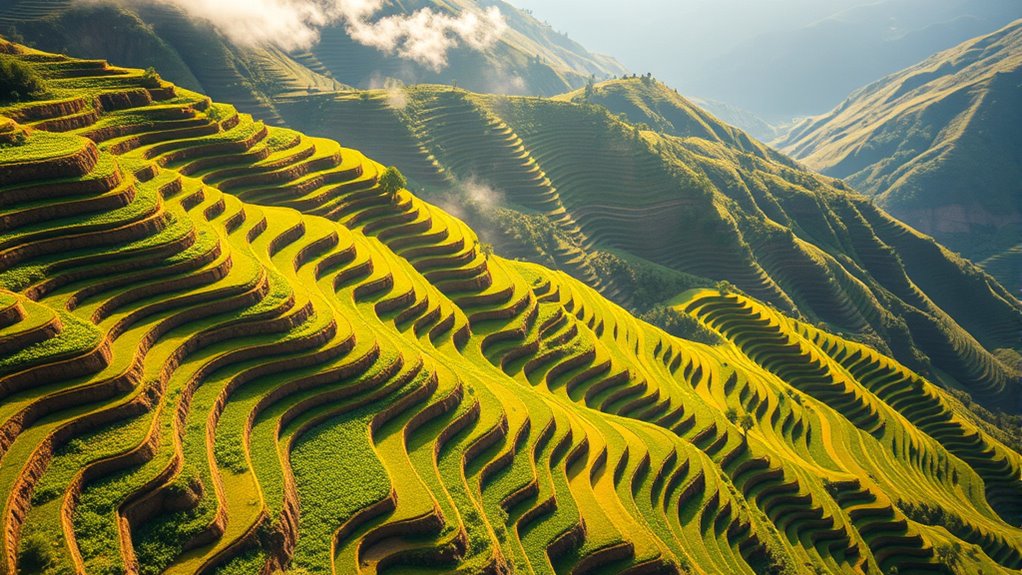
While terrace farming boosts agricultural productivity and local economies, it also plays a significant role in shaping environmental outcomes.
By reducing soil erosion, terraces help retain vital soil particles, enhancing fertility over time. They manage soil moisture effectively, preventing waterlogging and drought, which is crucial for healthy crops.
Additionally, terracing minimizes runoff, reducing sediment pollution in nearby water bodies. This practice supports biodiversity, creating habitats for various plant and animal species.
With a low carbon footprint, terrace farming contributes to climate adaptation and resilience against extreme weather.
Challenges and Limitations of Terrace Farming
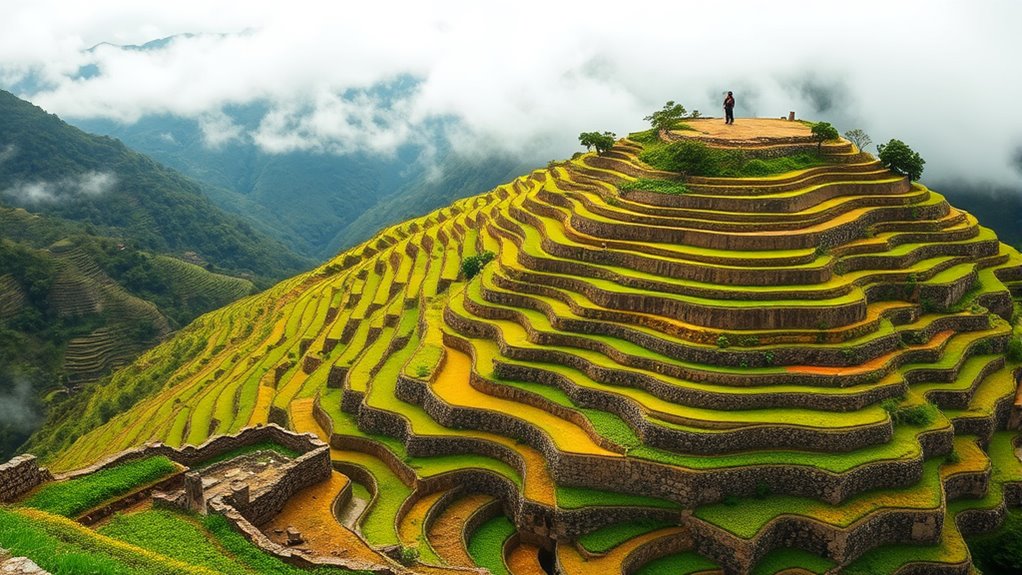
Though terrace farming offers numerous benefits, several challenges and limitations can hinder its effectiveness. You might face limited land area, making maintenance of narrow terraces more demanding.
Soil disturbance during construction can affect topsoil quality, while steep slopes increase the risk of wall collapse. Access to resources can be an issue; without proper mechanization, labor demands soar, and poor access to inputs restricts yield improvements.
Economic constraints also play a role, with high maintenance costs and limited cash income impacting profitability. Additionally, traditional practices and a lack of modern knowledge can stifle innovation, leaving you reliant on outdated methods.
Ultimately, these challenges require careful consideration to maximize the potential of terrace farming.
Modern Applications and Technological Advancements
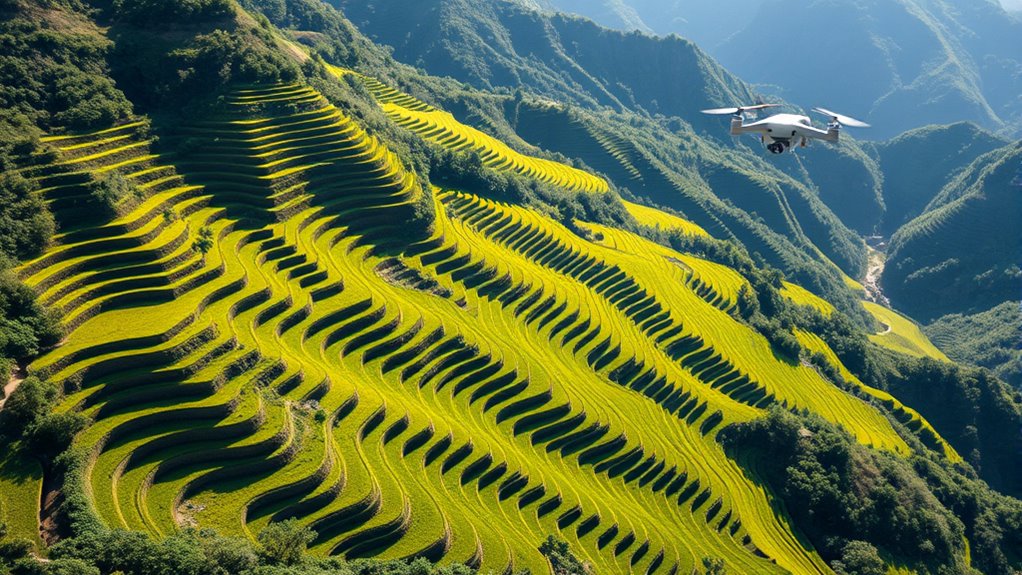
Despite the challenges faced in terrace farming, modern applications and technological advancements are transforming how farmers manage their operations.
With precision agriculture software, you can analyze soil health and weather patterns, optimizing your planting and harvesting schedules. IoT-based smart irrigation systems automate water distribution, ensuring you avoid overwatering and drought stress. Data analytics help forecast weather and soil erosion risks, allowing you to adjust your strategies effectively.
Additionally, digital farm-to-market platforms connect you directly with consumers, maximizing profits. Satellite imagery and drone technology enable real-time monitoring of crops, while blockchain solutions enhance food safety and transparency.
These advancements not only improve efficiency but also promote sustainable practices, ensuring a brighter future for terrace farming.
Cultural Importance of Terrace Farming
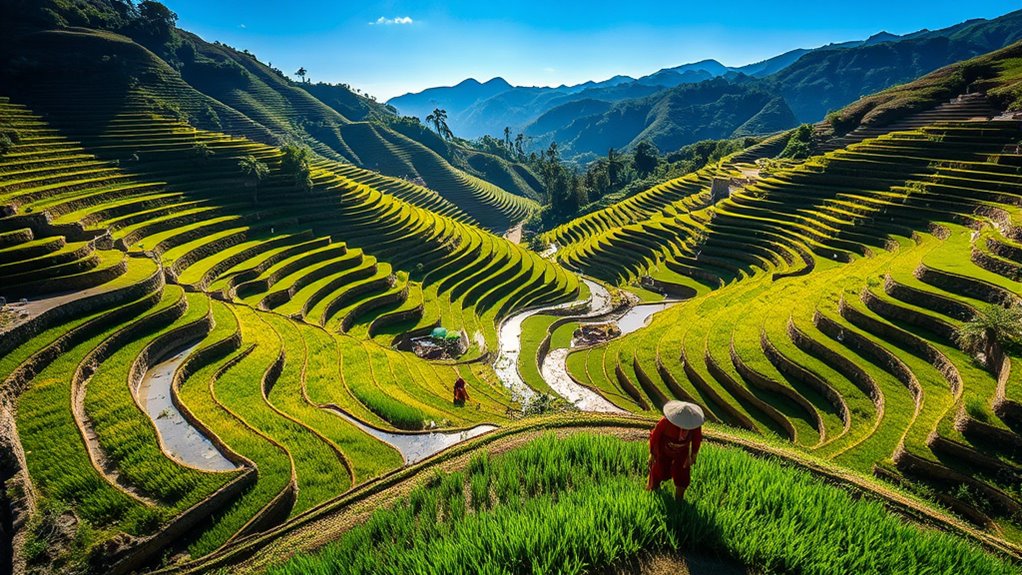
Terrace farming holds immense cultural significance, especially in communities where it's been practiced for generations. This ancient technique, seen in places like the Andes and Southeast Asia, fosters social cohesion through cooperative labor.
As you engage in terrace farming, you participate in a rich tradition that not only ensures food security but also supports local economies by generating income through surplus crops. The terraces symbolize the ingenuity and resilience of your culture, preserving ancestral knowledge and strengthening cultural identity.
Furthermore, as you maintain these terraces, you help safeguard your community's heritage, ensuring that future generations can appreciate and benefit from this vital agricultural practice.
Frequently Asked Questions
What Crops Are Best Suited for Terrace Farming?
When you consider crops for terrace farming, think about grains like wheat and maize, legumes such as pulses, and vegetables including potatoes and leafy greens.
Fruits like apples and subtropical varieties thrive too. For specialty crops, you can't go wrong with saffron or medicinal plants.
Depending on your climate, you'll want to select rainfed crops like maize or irrigated options like rice to maximize your yield and soil health.
How Does Terrace Farming Affect Local Wildlife?
Imagine a bustling marketplace where diverse creatures mingle, each finding their niche.
Terrace farming reshapes this marketplace, creating new habitats while sometimes displacing familiar faces. You'll notice that some species thrive in this structured environment, enjoying richer food sources and nesting spots.
However, others may struggle, facing challenges in adaptation. As you observe, remember that the balance of life hinges on how these terraced landscapes support or hinder local wildlife populations.
What Are the Labor Requirements for Terrace Farming?
In terrace farming, you'll find that labor requirements are quite high.
Constructing and maintaining terraces demands significant physical effort, often needing skilled workers to ensure everything's done correctly.
You'll spend a lot of time on manual tasks, as heavy machinery isn't always suitable for the terrain.
Seasonal labor peaks during planting and harvesting, so you might see job opportunities fluctuate, allowing local communities to engage and contribute to the farming process.
Can Terrace Farming Be Practiced in Urban Areas?
Absolutely, you can practice terrace farming in urban areas! Just like the hanging gardens of Babylon, your rooftop can flourish with greenery.
You'll transform unused spaces into vibrant gardens, growing fresh produce right at home. Start by assessing your roof's strength and sunlight, then choose easy-to-grow plants.
With efficient irrigation and community support, you'll not only cultivate crops but also enhance your urban environment, creating a little oasis amidst the concrete jungle.
What Are the Economic Implications of Terrace Farming?
The economic implications of terrace farming are significant for you as a farmer.
You'll see increased crop yields, which boosts your income. With surplus produce, you can sell in local markets and enhance your financial stability.
This method also creates job opportunities in your community.
Conclusion
In the tapestry of agriculture, terrace farming stands as a resilient thread, weaving together tradition and innovation. It's more than just a technique; it's a lifeline for communities, transforming steep hillsides into thriving fields of hope. As you reflect on its significance, picture those layered fields—each one a step toward sustainability and harmony with nature. Embracing terrace farming means nurturing not just the land, but also the spirit of those who cultivate it, ensuring a vibrant future for generations to come.

